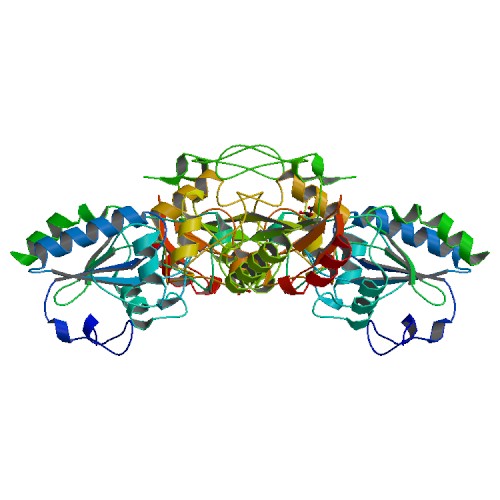GPX1
| Glutathione peroxidase 1 | |||||||||||||
|---|---|---|---|---|---|---|---|---|---|---|---|---|---|
 PDB rendering based on 2f8a. | |||||||||||||
| |||||||||||||
| Identifiers | |||||||||||||
| Symbols | GPX1 ; GSHPX1; MGC14399; MGC88245 | ||||||||||||
| External IDs | Template:OMIM5 Template:MGI HomoloGene: 20155 | ||||||||||||
| |||||||||||||
| Orthologs | |||||||||||||
| Template:GNF Ortholog box | |||||||||||||
| Species | Human | Mouse | |||||||||||
| Entrez | n/a | n/a | |||||||||||
| Ensembl | n/a | n/a | |||||||||||
| UniProt | n/a | n/a | |||||||||||
| RefSeq (mRNA) | n/a | n/a | |||||||||||
| RefSeq (protein) | n/a | n/a | |||||||||||
| Location (UCSC) | n/a | n/a | |||||||||||
| PubMed search | n/a | n/a | |||||||||||
Glutathione peroxidase 1, also known as GPX1, is a human gene.
This gene encodes a member of the glutathione peroxidase family. Glutathione peroxidase functions in the detoxification of hydrogen peroxide, and is one of the most important antioxidant enzymes in humans. It has been reported that the protein encoded by this gene protects from CD95-induced apoptosis in cultured breast cancer cells and inhibits 5-lipoxygenase in blood cells, and its overexpression delays endothelial cell growth and increases resistance to toxic challenges. This protein is one of only a few proteins known in higher vertebrates to contain selenocysteine, which occurs at the active site of glutathione peroxidase and is coded by the nonsense (stop) codon TGA. In addition, this protein is characterized in a polyalanine sequence polymorphism in the N-terminal region, which includes three alleles with five, six or seven alanine (ALA) repeats in this sequence. The allele with five ALA repeats is significantly associated with breast cancer risk. Two alternatively spliced transcript variants encoding distinct isoforms have been found for this gene.[1]
References
Further reading
- Moscow JA, Morrow CS, He R; et al. (1992). "Structure and function of the 5'-flanking sequence of the human cytosolic selenium-dependent glutathione peroxidase gene (hgpx1)". J. Biol. Chem. 267 (9): 5949–58. PMID 1556108.
- Chada S, Le Beau MM, Casey L, Newburger PE (1990). "Isolation and chromosomal localization of the human glutathione peroxidase gene". Genomics. 6 (2): 268–71. PMID 2307470.
- Mullenbach GT, Tabrizi A, Irvine BD; et al. (1987). "Sequence of a cDNA coding for human glutathione peroxidase confirms TGA encodes active site selenocysteine". Nucleic Acids Res. 15 (13): 5484. PMID 2955287.
- Mullenbach GT, Tabrizi A, Irvine BD; et al. (1989). "Selenocysteine's mechanism of incorporation and evolution revealed in cDNAs of three glutathione peroxidases". Protein Eng. 2 (3): 239–46. PMID 2976939.
- Sukenaga Y, Ishida K, Takeda T, Takagi K (1987). "cDNA sequence coding for human glutathione peroxidase". Nucleic Acids Res. 15 (17): 7178. PMID 3658677.
- Ishida K, Morino T, Takagi K, Sukenaga Y (1988). "Nucleotide sequence of a human gene for glutathione peroxidase". Nucleic Acids Res. 15 (23): 10051. PMID 3697069.
- Moscow JA, Schmidt L, Ingram DT; et al. (1995). "Loss of heterozygosity of the human cytosolic glutathione peroxidase I gene in lung cancer". Carcinogenesis. 15 (12): 2769–73. PMID 8001233.
- Maruyama K, Sugano S (1994). "Oligo-capping: a simple method to replace the cap structure of eukaryotic mRNAs with oligoribonucleotides". Gene. 138 (1–2): 171–4. PMID 8125298.
- Chu FF, Doroshow JH, Esworthy RS (1993). "Expression, characterization, and tissue distribution of a new cellular selenium-dependent glutathione peroxidase, GSHPx-GI". J. Biol. Chem. 268 (4): 2571–6. PMID 8428933.
- Esworthy RS, Ho YS, Chu FF (1997). "The Gpx1 gene encodes mitochondrial glutathione peroxidase in the mouse liver". Arch. Biochem. Biophys. 340 (1): 59–63. doi:10.1006/abbi.1997.9901. PMID 9126277.
- Suzuki Y, Yoshitomo-Nakagawa K, Maruyama K; et al. (1997). "Construction and characterization of a full length-enriched and a 5'-end-enriched cDNA library". Gene. 200 (1–2): 149–56. PMID 9373149.
- Opalenik SR, Ding Q, Mallery SR, Thompson JA (1998). "Glutathione depletion associated with the HIV-1 TAT protein mediates the extracellular appearance of acidic fibroblast growth factor". Arch. Biochem. Biophys. 351 (1): 17–26. doi:10.1006/abbi.1997.0566. PMID 9501919.
- Kiss C, Li J, Szeles A; et al. (1998). "Assignment of the ARHA and GPX1 genes to human chromosome bands 3p21.3 by in situ hybridization and with somatic cell hybrids". Cytogenet. Cell Genet. 79 (3–4): 228–30. PMID 9605859.
- Forsberg L, de Faire U, Morgenstern R (1999). "Low yield of polymorphisms from EST blast searching: analysis of genes related to oxidative stress and verification of the P197L polymorphism in GPX1". Hum. Mutat. 13 (4): 294–300. doi:10.1002/(SICI)1098-1004(1999)13:4<294::AID-HUMU6>3.0.CO;2-5. PMID 10220143.
- Choi J, Liu RM, Kundu RK; et al. (2000). "Molecular mechanism of decreased glutathione content in human immunodeficiency virus type 1 Tat-transgenic mice". J. Biol. Chem. 275 (5): 3693–8. PMID 10652368.
- Legault J, Carrier C, Petrov P; et al. (2000). "Mitochondrial GPx1 decreases induced but not basal oxidative damage to mtDNA in T47D cells". Biochem. Biophys. Res. Commun. 272 (2): 416–22. doi:10.1006/bbrc.2000.2800. PMID 10833429.
- Straif D, Werz O, Kellner R; et al. (2001). "Glutathione peroxidase-1 but not -4 is involved in the regulation of cellular 5-lipoxygenase activity in monocytic cells". Biochem. J. 349 (Pt 2): 455–61. PMID 10880344.
- Richard MJ, Guiraud P, Didier C; et al. (2001). "Human immunodeficiency virus type 1 Tat protein impairs selenoglutathione peroxidase expression and activity by a mechanism independent of cellular selenium uptake: consequences on cellular resistance to UV-A radiation". Arch. Biochem. Biophys. 386 (2): 213–20. doi:10.1006/abbi.2000.2197. PMID 11368344.
- Ishibashi N, Prokopenko O, Reuhl KR, Mirochnitchenko O (2002). "Inflammatory response and glutathione peroxidase in a model of stroke". J. Immunol. 168 (4): 1926–33. PMID 11823528.
- Gouaze V, Andrieu-Abadie N, Cuvillier O; et al. (2003). "Glutathione peroxidase-1 protects from CD95-induced apoptosis". J. Biol. Chem. 277 (45): 42867–74. doi:10.1074/jbc.M203067200. PMID 12221075.
| This protein-related article is a stub. You can help Wikipedia by expanding it. |